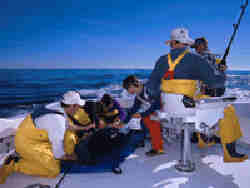Earth Sciences
Earth Sciences (also referred to as Geosciences), which deals with basic issues surrounding our planet, plays a vital role in the area of energy and raw materials supply.
Earth Sciences comprises subjects such as geology, geography, geological informatics, paleontology, mineralogy, petrography, crystallography, geophysics, geodesy, glaciology, cartography, photogrammetry, meteorology and seismology, early-warning systems, earthquake research and polar research.

Seabed Research Will Have Global Significance
Sediments in the Arabian Sea will be examined by an international scientific expedition led by a researcher from the University of Edinburgh to increase understanding of the natural processes of the ocean floor and establish its significance for global cycles and climate change. Robotic research platforms will be deployed on the sea floor to study deep-sea organisms and their impacts on sedimentary processes, without removing the creatures from their natural environment. Monsoons—winds that blow in o

Tagging the great white shark…and a few of his friends
What will some 4,000 of the smartest dressed elephant seals, tuna fish, albatrosses, leatherback sea turtles, great white sharks, and other pelagic megafauna in the Pacific all be wearing in the coming seasons? How about the latest in microprocessor-based electronic tags, some no bigger than oversized cufflinks? It’s all in a continuing effort to understand the habits of marine animals in that part of the world: what exactly lives where and why, what their migration routes and diving behaviors m

Scientists zero in on Arctic, hemisphere-wide climate swings
In the late 1990s, as scientists were reaching consensus that the Arctic had gone through 30 years of significant climate change, they began reading the first published papers about the Arctic Oscillation, a phenomenon reported to have hemisphere-wide effects.
In short order the arctic-science and the global-change communities were galvanized, says Richard Moritz, polar oceanographer with the UW’s Applied Physics Laboratory and lead author of a review of recent Arctic climate change in

Atmospheric wave linked to sea ice flow near Greenland, study finds
A NASA researcher finds that the amount of sea ice that moves between Greenland and Spitsbergen, a group of islands north of Norway, is dependent upon a “wave” of atmospheric pressure at sea level. By being able to estimate how much sea ice is exported through this region, called Fram Strait, scientists may develop further insights into how the ice impacts global climate.
This export of sea ice helps control the thermohaline circulation, a deep water ocean conveyor belt that moves warm, sal

Frigid South Pole atmosphere reveals flaw in global circulation models
Atmospheric measurements made at Earth’s geographic poles provide a convenient way of validating and calibrating global circulation models. Such measurements also might provide some of the first conclusive evidence of global change in the middle and upper atmospheres. But new data shows that the current models are wrong: Temperatures over the South Pole are much colder in winter than scientists had anticipated.
As reported in the Aug. 28 issue of Geophysical Research Letters, scientist

Satellites show overall increases in antarctic sea ice cover
Satellites show overall increases in antarctic sea ice coverWhile recent studies have shown that on the whole Arctic sea ice has decreased since the late 1970s, satellite records of sea ice around Antarctica reveal an overall increase in the southern hemisphere ice over the same period. Continued decreases or increases could have substantial impacts on polar climates, because sea ice spreads over a vast area, reflects solar radiation away from the Earth’s surface, and insulates the oceans from t